|
 Cortinarius napivelatus Cortinarius napivelatus
SynonymsThaxterogaster napivelatus
BiostatusPresent in region - Indigenous. Endemic
Images (click to enlarge)
Caption: Spores about 10-11 x 7 µm, finely warted, radially symetrical, ends broadly rounded. The spore shape exactly as illustrated for C. napivelatum by Horak, the spores of C. epiphaeus similar in size but ends more narrow.
Owner: Herb PDD | 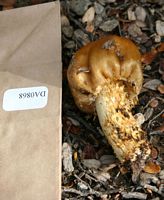
Owner: I. Dickie | 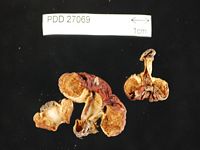
Caption: Dried type specimen
Owner: Herb PDD | 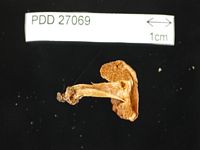
Caption: Dried type specimen
Owner: Herb PDD | 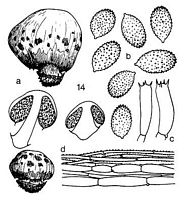
Caption: Thaxterogaster napivelatum Hk. sp. n. (type): a.
fruiting bodies. b. spores. c. basidia. d. cuticle. | 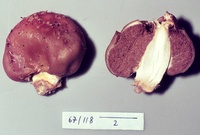
Caption: ZT67-118
Owner: E. Horak: © Creative Commons Attribution-Noncommercial 3.0 New Zealand | 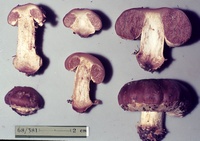
Caption: ZT68-381 , Holotype
Owner: E. Horak: © Creative Commons Attribution-Noncommercial 3.0 New Zealand |
Article: Horak, E. (1973). Fungi Agaricini Novazelandiae I-V. Beihefte zur Nova Hedwigia 43: 200 p.
Description: Gastrocarp
20-50 x 10-35 mm, globose or depressed globose, margin broadly enrolled and
dehiscent from the stipe, (date) brown or yellow-brown, densely covered with
small ochraceous patches from the veil, veil remnants becoming larger towards
the margin, viscid when wet, otherwise dry, innate-fibrillose, slightly hygrophanous.
Peridium 1-4 mm thick, cartilaginous. Gleba loculate or sublamelliform, cells
1-5 mm diam., rust brown, tramal plates well developed, whitish, branching from
the inner layer of the peridium into the gleba, dehiscent from upper parts of
the stipe, never exposed but covered with whitish-yellow, fibrillose hyphae
of the 'cortina'. Stipe 15-60 x 6-15(-20) mm, cylindric, attenuated towards
the apex or equal, turbinate-bulbous or marginate at the base, margin of base
dentate because of conspicuous, ochraceous or ferruginous remnants of the veil,
remnants occasionally even forming a membranous volva, dry, fibrillose, yellowish-ochraceous.
Context yellowish-brownish, watery. Odor and taste not distinctive. Chemical
reaction on peridium: KOH or HCl - negative.
Spores
10-12 x 6-8 µm, ovate or broadly elliptic, minutely verrucose, warts coarser
around the apex, without distinct perisporium, mostly bilaterally symmetric.
Basidia 25-35 x 6-8 µm, 4-spored. Cystidia absent. Epicutis consisting of cylindric,
repent, slightly gelatinised hyphae forming a cutis, membranes thin-walled,
encrusted with brown pigment. Septae with clamp connections.
Habitat: On
ground under Nothofagus fusca, N. menziesii and N. cliffortioides. New Zealand.
Notes: Microscopically
this species resembles Th. epiphaeum Hk.; both taxa possess small, minute,
verrucose and elliptic spores but they are easily separated by their macroscopical
characters. Th. napivelatum Hk. represents one of the most common species
of that genus in New Zealand. - There is no doubt that Th. napivelatum
Hk. from New Zealand is related to Th. mustella Moser and Th. carneoroseum
Hk., hitherto known only from beech forests in South America. The three species
have in common the marginate stipe, the colour of the gastrocarp and the minutely
warted, ovate spores.
|